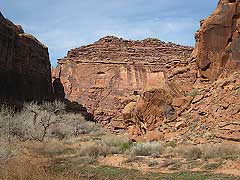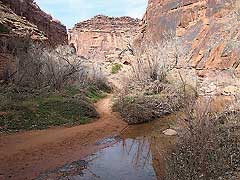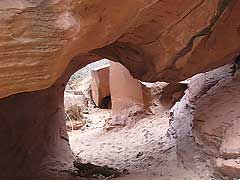Hunter Canyon - Springtime Anticipation by Marcy Hafner |
During a recent hike in Hunter Canyon I wondered - Where is all this water coming from? After all, we do live in the desert that receives just seven to ten inches of precipitation a year. So a free-flowing stream in an arid land seems strangely out of place. 
To answer this puzzling question, we would need to follow a trickle of water underground for miles on a journey that may take years to complete. Sandstone is fairly porous which allows water to drip downward. Moving laterally above an impervious layer of hard rock, the water flows along the path of least resistance. When it finally reaches a canyon wall, it surfaces as a life-giving spring.
This phenomenon is what makes Hunter Canyon so unique. Springs and seeps are its specialty - a treasure trove filled with an abundance of wetland surprises. In the spring and summer water gushes over sloping slides of sandstone and fills up stone basin pools before it cascades over rocky ledges. Then in the fall and winter the flow becomes intermittent as it hunkers down beneath the sand and gravel bed surfacing only when forced up by pressure from the solid rock below.
 To get to Hunter Canyon, drive south on Main Street (Highway 191) and turn right at McDonald’s on to Kane Creek Blvd. At the three-way stop sign continue straight. After driving 7.5 miles you will see the parking area for the canyon on the left, one mile beyond the switchbacks. Since only hikers and horseback riders are allowed, it is usually a peaceful place to go on a well-marked trail that gains just 240-feet in elevation. After the first mile, however, it gets a little tricky as spurs quickly lead to dead-ends. Then it is necessary to backtrack a short distance to pick up the main route again.
To get to Hunter Canyon, drive south on Main Street (Highway 191) and turn right at McDonald’s on to Kane Creek Blvd. At the three-way stop sign continue straight. After driving 7.5 miles you will see the parking area for the canyon on the left, one mile beyond the switchbacks. Since only hikers and horseback riders are allowed, it is usually a peaceful place to go on a well-marked trail that gains just 240-feet in elevation. After the first mile, however, it gets a little tricky as spurs quickly lead to dead-ends. Then it is necessary to backtrack a short distance to pick up the main route again.
On a partly cloudy day in early March, I commence my anticipation-of-spring walk. As I pass by some walk-in campsites, I think - what a beautiful creek side location for a sleepover. Leaving them behind, I continue on to relish the riparian lushness of willows, cottonwoods, Mormon tea, cliffrose, rabbitbrush, Gambel’s oak, junipers, claret cup cactus, and prickly pear with huge pads called tunas. All through this vibrant canyon the earth is wakening with new life including verdant green grass and the fresh sprouts of vetch, globemallow, pentstemon, hairy golden aster, and Prince’s plume.
I am, however, way ahead of myself in the expectation of finding wildflowers. Their season is yet to come with one exception - the teeny lavender blossoms of cave primrose. Found only in hanging gardens, these plants nourished by tricklets of water, cling tenaciously to their vertical world.
 Searching over the expansive reddish walls of Wingate Sandstone, I find whitewashed ledges that indicate where larger birds, such as ravens and hawks, like to hang out. Another distinctive coloration on these surfaces is the dark, lustrous coating of desert varnish - a composition of either manganese or iron oxide that has slowly leached from inside the rock wall.
Searching over the expansive reddish walls of Wingate Sandstone, I find whitewashed ledges that indicate where larger birds, such as ravens and hawks, like to hang out. Another distinctive coloration on these surfaces is the dark, lustrous coating of desert varnish - a composition of either manganese or iron oxide that has slowly leached from inside the rock wall.
The easy stream crossings provide abundant access to a variety of pools that reflect the rock walls and leafless cottonwoods. The bigger, clearer collections of water suggest an outdoor aquarium filled with darting schools of minnows with a few tadpoles that hopefully will live long enough to become frogs. But I am most intrigued with the water striders, also known as “Jesus bugs” or “pond skaters,” because these amazing aquatic insects literally walk on water! The key for this remarkable feat lies in the water repellent hairs on their legs that hold bubbles of air.
Fascinated with the cattails still pregnant with seed, I can’t resist giving them an extra boost for their journey to a new home. As soon as the casings are broken, hundreds of seeds are broadcasted in to the air, and instantly the breeze carries them upstream.
Short of a mile, I reach a whopper of a seal-shaped rock that has rolled down to the edge of the creek. Underneath this monstrosity daylight pours through with a gap that’s tall enough for me to easily walk underneath it. Once on the other side I survey the cliff wall to my right, and near the top – there it is – Hunter Arch. Oddly shaped the long lateral extension surrounds a 74-foot opening, which gives it the appearance of a pitcher’s handle.
Rough-barked cottonwoods dot this whole canyon. Some stand stately and tall, while others twist and bend to the ground. In the spring and summer, their shade brings welcome relief from the radiant rays of the sun. Scattered groves of Gambel’s oak also thrive from this extra boost of moisture. Named after William Gambel, an avid western plant collector, these trees with a height of up to 30 feet provide an important browse and shelter for deer.
After covering approximately two miles, I discover that I am now walking on a ghost of a trail that gradually disappears in the brush. Since I have no desire to bushwhack the rest of the way to the end of the canyon, it is definitely time for me to turn around. But first I need a break in the shade. Despite a chalky blue sky, the filtered sun still radiates too much warmth. After finding the perfect spot, I plop myself down on the edge of this refreshing course of water. Surprisingly no one else has ventured this far and my riparian reflections remain undisturbed, a rare reprieve on this popular trail.
Grabbing a snack, I kick back to soak in this oasis in the desert – rabbitbrush still loaded with its last harvest of seed – another rock garden of prickly pear – a raven calling from afar – a red-tailed hawk breezing on by – the small cottonwoods, oaks and junipers blessed with a steady supply of water – tiny lizards racing back and forth – and mourning cloaks and white butterflies flitting around.
How things change. It wasn’t that long ago I was chasing the winter sun. Now I am switching gears in anticipation of spring and the changes ahead - trees clothed in leafy green - the mystery of migration – the bouncing-down-the-scale song of the canyon wren - and the three-note serenade of the spotted towhee. With more daylight and warmer temperatures, I am happily shedding my heavy winter clothes as I look forward to the best show on earth - the explosion of desert wildflowers with colors galore.
Oh yes, I can hardly wait and soon enough it will be here.